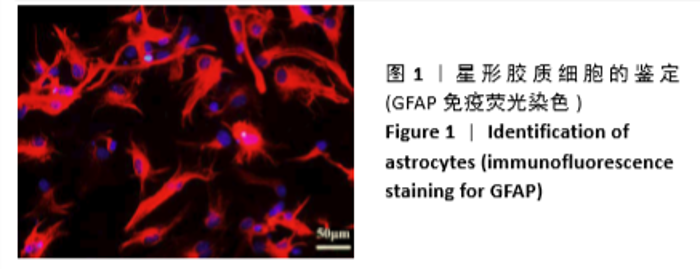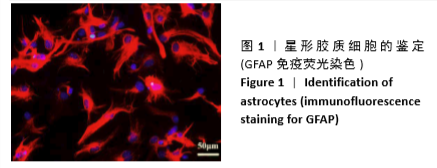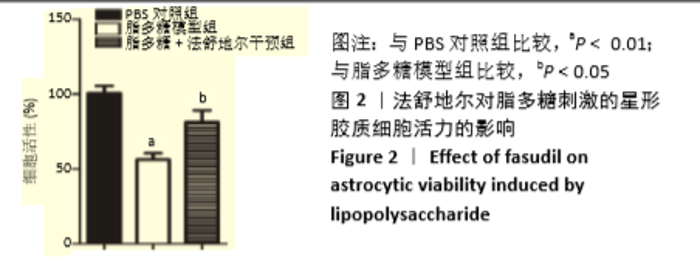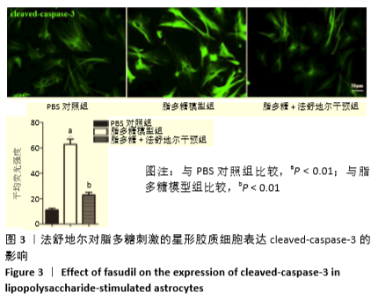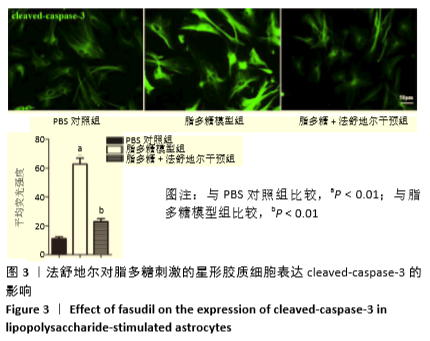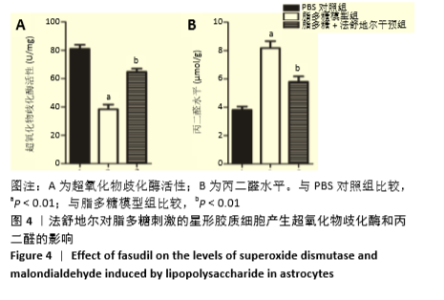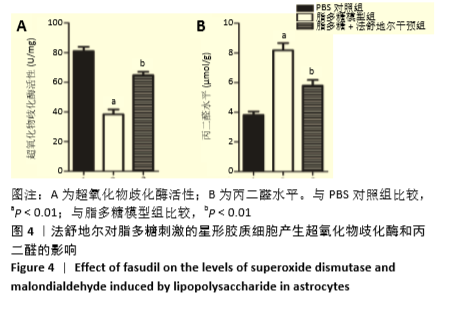Chinese Journal of Tissue Engineering Research ›› 2021, Vol. 25 ›› Issue (31): 5012-5017.doi: 10.12307/2021.144
Previous Articles Next Articles
Fasudil inhibits lipopolysaccharide-induced astrocytic injury by regulating Nrf2/HO-1 signaling pathway
Guo Minfang1, Zhang Huiyu1, Zhang Peijun1, Bai Zhenjun1, Yu Jingwen1, Wang Yuyin1, 2, Wei Wenyue1, 3, Song Lijuan2, 3, Chai Zhi2, Yu Jiezhong1, 4, Ma Cungen1, 2
-
Received:2020-07-24Revised:2020-07-25Accepted:2020-08-19Online:2021-11-08Published:2021-04-25 -
Contact:Ma Cungen, MD, Professor, Doctoral supervisor, Institute of Brain Science, Shanxi Datong University/Key Laboratory of Shanxi Province for Basic and Applied Research on Neuroinflammation and Degenerative Diseases, Datong 037009, Shanxi Province, China; Key Laboratory of Multiple Sclerosis, Nourishing Qi and Activating Blood, National Administration of Traditional Chinese Medicine/Neurobiology Research Center, Shanxi University of Chinese Medicine, Jinzhong 030619, Shanxi Province, China -
About author:Guo Minfang, Master, Associate professor, Institute of Brain Science, Shanxi Datong University/Key Laboratory of Shanxi Province for Basic and Applied Research on Neuroinflammation and Degenerative Diseases, Datong 037009, Shanxi Province, China -
Supported by:the Shanxi Province Platform Base Special Project, No. 201805D111009 (to MCG), No. 201805D131005 (to YJZ); the Science and Technology Innovation Project of Shanxi Colleges and Universities, No. 2020L0484 (to GMF); the Opening Project of Key Laboratory of Shanxi Province for Basic and Applied Research on Neuroinflammation and Degenerative Diseases, No. KF2019007 (to GMF)
CLC Number:
Cite this article
Guo Minfang, Zhang Huiyu, Zhang Peijun, Bai Zhenjun, Yu Jingwen, Wang Yuyin, Wei Wenyue, Song Lijuan, Chai Zhi, Yu Jiezhong, Ma Cungen. Fasudil inhibits lipopolysaccharide-induced astrocytic injury by regulating Nrf2/HO-1 signaling pathway[J]. Chinese Journal of Tissue Engineering Research, 2021, 25(31): 5012-5017.
share this article
Add to citation manager EndNote|Reference Manager|ProCite|BibTeX|RefWorks

2.5 法舒地尔对脂多糖刺激星形胶质细胞表达Nrf2的调节作用 该研究进一步分析了Nrf2的表达及其核转移的情况以探讨法舒地尔改善脂多糖对星形胶质细胞氧化损伤作用的机制。免疫荧光结果显示,PBS对照组Nrf2主要分布在细胞质中,细胞核中的含量较少;脂多糖模型组细胞质和细胞核内Nrf2含量均减少,而法舒地尔作用24 h后,细胞核中的Nrf2含量明显增加,说明法舒地尔可以促进Nrf2向核内转移。Western blot蛋白定量结果发现,与PBS对照组比较,脂多糖模型组总Nrf2和细胞核内Nrf2表达均降低(P < 0.01),而法舒地尔作用24 h后,总Nrf2和细胞核内Nrf2表达均明显增加(P < 0.01),见图5,进一步说明法舒地尔可以使Nrf2激活并促进其向核内转移。"

| [1] LIGUORI I, RUSSO G, CURCIO F, et al. Oxidative stress, aging, and diseases. Clin Interv Aging. 2018;13:757-772. [2] TOBORE TO. On the central role of mitochondria dysfunction and oxidative stress in Alzheimer’s disease. Neurol Sci. 2019;40(8):1527-1540. [3] POHANKA M. Oxidative stress in Alzheimer disease as a target for therapy. Bratisl Lek Listy. 2018;119(9):535-543. [4] MATSCHKE V, THEISS C, MATSCHKE J. Oxidative stress: the lowest common denominator of multiple diseases. Neural Regen Res. 2019;14(2):238-241. [5] FRAUNBERGER EA, SCOLA G, LALIBERTÉ VL, et al. Redox Modulations, Antioxidants, and Neuropsychiatric Disorders. Oxid Med Cell Longev. 2016; 2016:4729192. [6] MCBEAN GJ. Cysteine, Glutathione, and Thiol Redox Balance in Astrocytes. Antioxidants (Basel). 2017;6(3):62. [7] CABEZAS R, BAEZ-JURADO E, HIDALGO-LANUSSA O, et al. Growth Factors and Neuroglobin in Astrocyte Protection Against Neurodegeneration and Oxidative Stress. Mol Neurobiol. 2019;56(4):2339-2351. [8] JOE EH, CHOI DJ, AN J, et al. Astrocytes, Microglia, and Parkinson’s Disease. Exp Neurobiol. 2018;27(2):77-87. [9] GONZÁLEZ-REYES RE, NAVA-MESA MO, VARGAS-SÁNCHEZ K, et al. Involvement of Astrocytes in Alzheimer’s Disease from a Neuroinflammatory and Oxidative Stress Perspective. Front Mol Neurosci. 2017;10:427. [10] RIZOR A, PAJARILLO E, JOHNSON J, et al. Astrocytic Oxidative/Nitrosative Stress Contributes to Parkinson’s Disease Pathogenesis: The Dual Role of Reactive Astrocytes. Antioxidants (Basel). 2019;8(8):265. [11] MOLINARI C, MORSANUTO V, GHIRLANDA S, et al. Role of Combined Lipoic Acid and Vitamin D3 on Astrocytes as a Way to Prevent Brain Ageing by Induced Oxidative Stress and Iron Accumulation. Oxid Med Cell Longev. 2019;2019:2843121. [12] SHEFA U, JEONG NY, SONG IO, et al. Mitophagy links oxidative stress conditions and neurodegenerative diseases. Neural Regen Res. 2019;14(5):749-756. [13] HAMDI Y, KADDOUR H, VAUDRY D, et al. The octadecaneuropeptide ODN protects astrocytes against hydrogen peroxide-induced apoptosis via a PKA/MAPK-dependent mechanism. PLoS One. 2012;7(8):e42498. [14] SANDBERG M, PATIL J, D’ANGELO B, et al. NRF2-regulation in brain health and disease: implication of cerebral inflammation. Neuropharmacology. 2014;79:298-306. [15] CAO S, CHAO D, ZHOU H, et al. A novel mechanism for cytoprotection against hypoxic injury: δ-opioid receptor-mediated increase in Nrf2 translocation. Br J Pharmacol. 2015;172(7):1869-1881. [16] NITURE SK, KASPAR JW, SHEN J, et al. Nrf2 signaling and cell survival. Toxicol Appl Pharmacol. 2010;244(1):37-42. [17] SHU L, WANG C, WANG J, et al. The neuroprotection of hypoxic preconditioning on rat brain against traumatic brain injury by up-regulated transcription factor Nrf2 and HO-1 expression. Neurosci Lett. 2016;611:74-80. [18] FU PC, TANG RH, YU ZY, et al. The Rho-associated kinase inhibitors Y27632 and fasudil promote microglial migration in the spinal cord via the ERK signaling pathway. Neural Regen Res. 2018;13(4):677-683. [19] YAN Y, YU J, GAO Y, et al. Therapeutic potentials of the Rho kinase inhibitor Fasudil in experimental autoimmune encephalomyelitis and the related mechanisms. Metab Brain Dis. 2019;34(2):377-384. [20] WANG J, SUI RX, MIAO Q, et al. Retraction: Effect of Fasudil on remyelination following cuprizone-induced demyelination. CNS Neurosci Ther. 2020;26(7):778. [21] 张慧宇,郭敏芳,于婧文,等.法舒地尔(Fasudil)抑制脂多糖诱导的小鼠星形胶质细胞活化和炎性反应及其机制[J].细胞与分子免疫学杂志, 2018,34(6):505-510. [22] WANG Y, ZHAO CS. Sigma-1 receptor activation ameliorates LPS-induced NO production and ROS formation through the Nrf2/HO-1 signaling pathway in cultured astrocytes. Neurosci Lett. 2019;711:134387. [23] POURHANIFEH MH, SHAFABAKHSH R, REITER RJ, et al. The Effect of Resveratrol on Neurodegenerative Disorders: Possible Protective Actions Against Autophagy, Apoptosis, Inflammation and Oxidative Stress. Curr Pharm Des. 2019;25(19):2178-2191. [24] CHERBUIN N, WALSH E, BAUNE BT, et al. Oxidative stress, inflammation and risk of neurodegeneration in a population sample. Eur J Neurol. 2019; 26(11):1347-1354. [25] SOFRONIEW MV, VINTERS HV. Astrocytes: biology and pathology. Acta Neuropathol. 2010;119(1):7-35. [26] PACHECO SM, AZAMBUJA JH, DE CARVALHO TR, et al. Glioprotective Effects of Lingonberry Extract Against Altered Cellular Viability, Acetylcholinesterase Activity, and Oxidative Stress in Lipopolysaccharide-Treated Astrocytes. Cell Mol Neurobiol. 2018;38(5):1107-1121. [27] SHARMA A, PATRO N, PATRO IK. Lipopolysaccharide-Induced Apoptosis of Astrocytes: Therapeutic Intervention by Minocycline. Cell Mol Neurobiol. 2016;36(4):577-592. [28] PORTER AG, JÄNICKE RU. Emerging roles of caspase-3 in apoptosis. Cell Death Differ. 1999;6(2):99-104. [29] SHU Q, FAN H, LI SJ, et al. Protective effects of Progranulin against focal cerebral ischemia-reperfusion injury in rats by suppressing endoplasmic reticulum stress and NF-κB activation in reactive astrocytes. J Cell Biochem. 2018;119(8):6584-6597. [30] OTTERBEIN LE, FORESTI R, MOTTERLINI R. Heme Oxygenase-1 and Carbon Monoxide in the Heart: The Balancing Act Between Danger Signaling and Pro-Survival. Circ Res. 2016;118(12):1940-1959. [31] LOBODA A, DAMULEWICZ M, PYZA E, et al. Role of Nrf2/HO-1 system in development, oxidative stress response and diseases: an evolutionarily conserved mechanism. Cell Mol Life Sci. 2016;73(17):3221-3247. [32] ALI T, KIM T, REHMAN SU, et al. Natural Dietary Supplementation of Anthocyanins via PI3K/Akt/Nrf2/HO-1 Pathways Mitigate Oxidative Stress, Neurodegeneration, and Memory Impairment in a Mouse Model of Alzheimer’s Disease. Mol Neurobiol. 2018;55(7):6076-6093. [33] JO MG, IKRAM M, JO MH, et al. Gintonin Mitigates MPTP-Induced Loss of Nigrostriatal Dopaminergic Neurons and Accumulation of α-Synuclein via the Nrf2/HO-1 Pathway. Mol Neurobiol. 2019;56(1):39-55. [34] HUNG SY, LIOU HC, FU WM. The mechanism of heme oxygenase-1 action involved in the enhancement of neurotrophic factor expression. Neuropharmacology. 2010;58(2):321-329. |
| [1] | Yang Yifeng, Ye Nan, Wang Lin, Guo Shuaicheng, Huang Jian. Signaling pathway of dexmedetomidine against ischemia-reperfusion injury [J]. Chinese Journal of Tissue Engineering Research, 2024, 28(9): 1464-1469. |
| [2] | Yue Yun, Wang Peipei, Yuan Zhaohe, He Shengcun, Jia Xusheng, Liu Qian, Li Zhantao, Fu Huiling, Song Fei, Jia Menghui. Effects of croton cream on JNK/p38 MAPK signaling pathway and neuronal apoptosis in cerebral ischemia-reperfusion injury rats [J]. Chinese Journal of Tissue Engineering Research, 2024, 28(8): 1186-1192. |
| [3] | Lou Guo, Zhang Yan, Fu Changxi. Role of endothelial nitric oxide synthase in exercise preconditioning-induced improvement of myocardial ischemia-reperfusion injury [J]. Chinese Journal of Tissue Engineering Research, 2024, 28(8): 1283-1288. |
| [4] | Liu Kexin, Song Lijuan, Wu Yige, Han Guangyuan, Miao Zhuyue, Wei Ruheng, Xiao Baoguo, Ma Cungen, Huang Jianjun. Hydroxysafflor yellow A intervenes astrocyte lipocalin 2 expression after cerebral ischemia/reperfusion injury [J]. Chinese Journal of Tissue Engineering Research, 2024, 28(7): 1063-1069. |
| [5] | Pan Xiaolong, Fan Feiyan, Ying Chunmiao, Liu Feixiang, Zhang Yunke. Effect and mechanism of traditional Chinese medicine on inhibiting the aging of mesenchymal stem cells [J]. Chinese Journal of Tissue Engineering Research, 2024, 28(7): 1091-1098. |
| [6] | Chen Zepeng, Hou Yonghui, Chen Shudong, Hou Yu, Lin Dingkun. Tauroursodeoxycholic acid treats spinal cord injury by reducing apoptosis of spinal cord neurons under glucose and oxygen deprivation [J]. Chinese Journal of Tissue Engineering Research, 2024, 28(4): 528-534. |
| [7] | Shen Feiyan, Yao Jixiang, Su Shanshan, Zhao Zhongmin, Tang Weidong. Knockdown of circRNA WD repeat containing protein 1 inhibits proliferation and induces apoptosis of chondrocytes in knee osteoarthritis [J]. Chinese Journal of Tissue Engineering Research, 2024, 28(4): 499-504. |
| [8] | Cao Sheng, Kong Lingwei, Xu Kun, Sun Zhijie. Effect of gelatin methacryloyl hydrogel loaded with salvianolic acid B on intervertebral disc degeneration [J]. Chinese Journal of Tissue Engineering Research, 2024, 28(3): 380-386. |
| [9] | Yang Qihang, Pu Rui, Chen Ziyang, Leng Siyi, Song Yongjing, Liu Hui, Du Guangyou. Role and mechanism of intestinal flora metabolites in obesity regulation [J]. Chinese Journal of Tissue Engineering Research, 2024, 28(2): 308-314. |
| [10] | Sun Yuan, Wang Qingbo, Pi Yihua, Lu Chunmin, Xu Chuanyi, Zhang Yan. Effects of early and late aerobic exercise on right heart failure induced by monocrotaline in rats with pulmonary hypertension [J]. Chinese Journal of Tissue Engineering Research, 2024, 28(2): 177-185. |
| [11] | Ran Lei, Han Haihui, Xu Bo, Wang Jianye, Shen Jun, Xiao Lianbo, Shi Qi. Molecular docking analysis of the anti-inflammatory mechanism of Cibotium barometz and Epimedium for rheumatoid arthritis: animal experiment validation [J]. Chinese Journal of Tissue Engineering Research, 2024, 28(2): 208-215. |
| [12] | Zuo Jun, Ma Shaolin. Mechanism of beta-sitosterol on hypertrophic scar fibroblasts: an analysis based on network pharmacology [J]. Chinese Journal of Tissue Engineering Research, 2024, 28(2): 216-223. |
| [13] | Wang Qian, Lu Ziang, Li Lihe, Lyu Chaoliang, Wang Meng, Zhang Cunxin. Sinomenine effectively inhibits interleukin-1beta-induced apoptosis in nucleus pulposus cells [J]. Chinese Journal of Tissue Engineering Research, 2024, 28(2): 224-230. |
| [14] | Chen Simin, Hu Yingjun, Yan Wenrui, Ji Le, Shao Mengli, Sun Ze, Zheng Hongxing, Qi Shanshan. Establishment and evaluation of a streptozotocin-induced diabetic encephalopathy rat model [J]. Chinese Journal of Tissue Engineering Research, 2024, 28(2): 237-241. |
| [15] | Xie Heng, Gu Ye, Gu Yingchu, Wu Zerui, Fang Tao, Wang Qiufei, Peng Yuqin, Geng Dechun, Xu Yaozeng. Ferroptosis in bone diseases: therapeutic targets of osteoporosis [J]. Chinese Journal of Tissue Engineering Research, 2024, 28(16): 2613-2618. |
| Viewed | ||||||
|
Full text |
|
|||||
|
Abstract |
|
|||||
